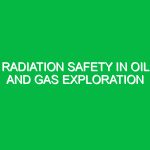The drilling industry plays a crucial role in extracting vital resources, including oil and natural gas. However, this essential operation comes with significant environmental implications. Understanding the Environmental Impact and Mitigation in Drilling Operations is key to fostering a sustainable future within the Health, Safety, and Environment (HSE) domain. This article delves into the multifaceted aspects of environmental impact, the potential hazards associated with drilling operations, and practical mitigation strategies to minimize these impacts.
Defining Environmental Impact and Mitigation in Drilling Operations
Environmental impact refers to the effect that drilling operations have on the surrounding ecosystem, including air, water, soil, and biodiversity. These impacts can range from habitat destruction to air pollution and contamination of water sources. Mitigation, on the other hand, involves strategies and practices implemented to reduce or eliminate negative environmental effects. In the context of drilling operations, mitigation is not just an afterthought; it is a fundamental component of responsible resource extraction and is vital for compliance with HSE regulations.
The relevance of this topic within the HSE framework cannot be overstated. Effective environmental management ensures the health and safety of workers, local communities, and ecosystems. It also helps companies avoid costly legal penalties and reputational damage. Thus, an in-depth understanding of environmental impacts and mitigation strategies is essential for industry stakeholders.
Identifying Hazards and Risks Associated with Drilling Operations
Drilling operations are fraught with potential hazards that can adversely affect the environment. Understanding these risks is the first step toward effective mitigation. Below are some of the primary environmental hazards associated with drilling:
1. Air Pollution
Air quality can suffer significantly due to emissions from drilling rigs, including volatile organic compounds (VOCs), methane, and particulate matter. These pollutants can contribute to smog formation and respiratory problems in nearby populations. For instance, a study conducted in the Barnett Shale region of Texas revealed that emissions from natural gas drilling operations correlated with increased respiratory issues among local residents (Source: Texas A&M University).
2. Water Contamination
Groundwater and surface water can be contaminated through spills, leaks, and improper disposal of drilling fluids. A notable example is the Deepwater Horizon oil spill in 2010, which resulted in catastrophic damage to marine habitats and local economies. The effects of such contamination can linger for decades, making prevention and mitigation critical.
3. Soil Degradation
Drilling activities can lead to soil erosion, compaction, and contamination. Heavy machinery and drilling waste can disrupt the natural soil structure, affecting its ability to support vegetation and wildlife. This degradation can have long-term consequences for local ecosystems.
4. Habitat Disruption
Drilling operations often require significant land disturbance, which can disrupt local wildlife habitats. The removal of vegetation and construction of access roads can fragment ecosystems, making it difficult for species to thrive and reproduce. This is particularly concerning in sensitive areas such as wetlands and forests.
5. Noise Pollution
The noise generated by drilling equipment and transportation can disturb wildlife and local communities. Prolonged exposure to high noise levels can lead to stress in animals and reduced quality of life for nearby residents. Studies have shown that noise pollution can alter animal behavior, making it an important factor to consider in environmental assessments.
Best Practices and Safety Precautions for Mitigating Environmental Impact
To address the environmental hazards associated with drilling operations, companies must adopt comprehensive mitigation strategies. Here are some actionable best practices:
1. Implementing Advanced Technologies
Utilizing advanced drilling technologies, such as horizontal drilling and hydraulic fracturing, can minimize surface disturbance and reduce the environmental footprint. These technologies allow for more efficient resource extraction while limiting the area affected by drilling operations. For example, multi-well pads reduce the need for extensive road networks, thereby minimizing habitat disruption.
2. Regular Environmental Assessments
Conducting regular environmental impact assessments (EIAs) can help identify potential risks before drilling begins. These assessments should evaluate air quality, water resources, and biodiversity to ensure that all possible impacts are accounted for. By engaging with local communities and stakeholders during this process, companies can gain valuable insights that may improve mitigation strategies.
3. Spill Prevention and Response Plans
Developing comprehensive spill prevention and response plans is crucial for protecting water resources. These plans should outline procedures for containing and cleaning up spills, as well as protocols for reporting incidents. Training employees on these procedures ensures readiness in the event of an emergency.
4. Waste Management Practices
Proper disposal of drilling waste is vital for minimizing environmental impact. Implementing practices such as recycling drilling fluids and using lined pits for waste storage can prevent contamination of soil and water. Moreover, adhering to strict regulations regarding waste management helps ensure compliance and protects the environment.
5. Community Engagement and Education
Engaging with local communities and educating them about drilling operations can foster trust and transparency. Companies should provide information about their environmental practices and encourage feedback. By involving the community in decision-making processes, companies can address concerns and enhance their social license to operate.
Regulations and Standards Governing Environmental Impact in Drilling Operations
Numerous regulations and standards oversee environmental impact and mitigation in drilling operations. These regulations vary by region but generally encompass several key areas:
1. Environmental Protection Agency (EPA) Regulations
In the United States, the EPA sets regulations to protect air and water quality, including the Clean Air Act and the Clean Water Act. These regulations require drilling companies to obtain permits and adhere to strict emissions and discharge standards.
2. Occupational Safety and Health Administration (OSHA) Standards
OSHA sets standards to protect the health and safety of workers in the drilling industry. These standards often intersect with environmental regulations, as safe practices can significantly reduce environmental risks.
3. International Standards
Various international standards, such as the ISO 14001 for Environmental Management Systems, provide frameworks for organizations to manage their environmental responsibilities. Adopting these standards can enhance a company’s credibility and commitment to sustainable practices.
Conclusion: The Path Forward
The Environmental Impact and Mitigation in Drilling Operations is a complex yet critical subject that necessitates a concerted effort from industry stakeholders. By understanding the potential hazards and implementing robust mitigation strategies, the drilling industry can significantly reduce its environmental footprint. As we advance into an era increasingly focused on sustainability, it is imperative that drilling operations evolve to meet environmental standards while ensuring the safety and health of workers and local communities.
Through innovation, community engagement, and adherence to regulations, the drilling industry can transform its practices to safeguard the environment and contribute positively to the HSE landscape. The ongoing dialogue about environmental responsibility is not just a regulatory requirement; it is a moral imperative that speaks to the future of our planet.


